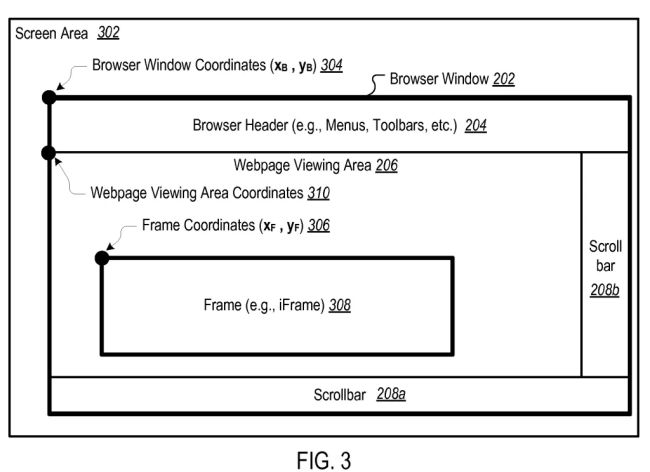- within Media, Telecoms, IT and Entertainment topic(s)
This EPO Board of Appeal decision concerns a patent application for determining the visibility of content on a web browser. In the appeal, the Board considered that determination is performed by measuring raw information about running web browsers to estimate a technically meaningful parameter. Such indirect measurement is normally of a technical nature.
This decision is one of the examples of applying the G 1/19 decision, where the EPO Enlarged Board noted that regardless of their use, indirect measurement relates to physical reality and is technical in nature. Here are the practical takeaways from the decision T 1422/19 (Content item visibility/GOOGLE) of 19.5.2021, of Technical Board of Appeal 3.5.07:
Key takeaways
Estimating the size of the browser's viewport from within a cross-domain iframe by indirect measurement is technical
Although the claim does not include technical use of the calculated/estimated content visibility, the method measures "raw" information about a running web browser and processes this information to produce an estimate of a technically meaningful parameter, namely the extent to which a content item displayed within a web page is visible to the user, and on the basis of technical considerations relating to what is possible with an unmodified browser that enforces standard security constraints. Such an indirect measurement is normally of a technical nature.
Finding a way to circumvent a technical problem may well form the basis for a patentable invention
The invention
The European patent application relates to determining the visibility of content, such as advertisements, presented in a web browser.
Conventional techniques to determine the visibility using code that runs from within a frame do not work due to browser security constraints. It prevents access to information such as the size of the browser's viewport, the size of the content item, and the content's item location relative to the browser's viewport.
The present application proposes a method that allows code to determine the visibility of a content item from within the content item's cross-domain iframe. This is achieved by calculating the overlap of the rectangle corresponding to the "webpage viewing area" and the rectangle corresponding to the content item.

Here is how the invention was defined in claim 1 of the main request of EP App no. 14768301.5:
Claim 1
A computer-implemented method (400) for determining content visibility when a content item is included in a cross-domain iframe (308), comprising:
determining (402) a first estimate of a size of a webpage viewing area (206) of a browser window (202) associated with a browser including (i) reading, from inside the iframe (308), an outer bound for size of the browser window (202), (ii) performing a statistical analysis to determine an average size of one or more browser elements (204, 208a, 208b) including determining a browser header (204) size based on historical measurements that are gathered as statistical data, and (iii) subtracting from the size of the browser window (202) the average size of the one or more browser elements (204, 208a, 208b);
determining (404) a second estimate for a size of the content item for display in the webpage viewing area (206), including reading iframe inside measurements for the iframe (308) from the browser;
determining (406) content item visibility including determining of a location of the content item relative to the webpage viewing area (206) by reading a location of the browser window (202) and, from inside the iframe (308), a location of the iframe (308) in screen coordinates and calculating how much of the content item is visible by determining an area of overlap of two rectangles, the first rectangle defined by the location of the browser window (202) and the estimate of the webpage viewing area (206), and the second rectangle defined by the location of the iframe (308) and the size of the content item; and
reporting (408) information about the visibility of the content item to a content sponsor.
Is it patentable?
In the first instance, the Examination Division considered that the invention aimed at ensuring the visibility of an advertisement on a web page thus concerns a non-technical, purely business-related problem. Therefore, the problem was defined as an alternative technical implementation of a non-technical problem. The examining division decided that the subject-matter of independent claims was obvious in view of document D1.
The Board disagreed with this assessment. According to the Board, the distinguishing feature solved a technical problem:
4.2 Document D1 does not disclose that the size of the viewport/web page viewing area is determined by reading the size of the browser window and subtracting from the size of the browser window the average size of one or more browser elements as determined by a statistical analysis based on historical measurements.
This distinguishing feature addresses the problem of estimating the size of the browser's viewport from within a cross-domain iframe. Due to security constraints, the size of the viewport cannot be accessed directly from within a cross-domain iframe (see paragraph [0020] of the published application).
The examining division also noted that the technical use of determining content visibility is not claimed. Therefore, since the output (i.e., content visibility) is used for a non-technical purpose but for advertisement, the solution was obvious given the non-technical requirement. The Board applied the finding from G 1/19, which discussed conditions when indirect measurements still related to physical reality are considered of technical nature regardless of the use of the result.
4.3 In its decision, the examining division argued that, although the determination of the estimated size of the viewport was performed with technical means, it corresponded to a technical implementation of a non-technical requirement, which was the rule used to compute the estimated size. This rule was non-technical because it was based on a business requirement and, since the determined output size was an estimated value, it circumvented the technical problem of actually measuring the viewing area rather than addressing it.
4.4 It is true that the method of claim 1 does not include a technical use of the calculated/estimated content visibility. In fact, the claim specifies that the information about the visibility of the content item is reported to a content sponsor. However, the method does not merely calculate this information from numerical input data but measures "raw" information about a running web browser and processes this information to produce an estimate of a technically meaningful parameter, namely the extent to which a content item displayed within a web page is visible to the user, and on the basis of technical considerations relating to what is possible with an unmodified browser that enforces standard security constraints. Such an indirect measurement is normally of a technical nature (see decision G 1/19, not yet published in the OJ EPO, point 99).
The examining division had also argued that the solution using estimation was merely a circumvention of the problem. The Board disagreed with this assessment:
4.5 As for the examining division's argument that the claim "circumvents" rather than addresses the technical problem of actually measuring the viewing area, the board notes that finding a way to circumvent a technical problem may well form the basis for a patentable invention.
The examining division's argument appears to be based on decision T 258/03, OJ EPO 2004, 575, Reasons 5.7, where the deciding board argued that "[m]ethod steps consisting of modifications to a business scheme and aimed at circumventing a technical problem rather than solving it by technical means cannot contribute to the technical character of the subject-matter claimed".
However, no business or other non-technical scheme is modified in the present case.
Although document D5 (Window outerWidth and outerHeight properties) was not discussed in the examining division's decision, the Board, in their preliminary opinion, considered that it would be obvious for a skilled person starting from D5. However, this finding was reconsidered based on the arguments by the applicant:
4.6 In its communication, the board suggested that in view of document D5, which disclosed that the width and the height of the browser window including browser elements such as toolbars and scroll bars could be obtained by means of the "window.outerWidth" and "window.outerHeight" properties, it would have been obvious to estimate the size of the browser's viewport in terms of width and height by determining the width and height of the browser window by means of these properties and correcting for browser elements. Since the sizes of browsers elements varied from browser to browser, they would have to be estimated, for example on the basis of statistical data.
4.7 However, on reconsideration the board is not convinced that, faced with the problem of obtaining the approximate size of the browser's viewport, the skilled person would, without any hint, decide to obtain instead the size of the browser window and then correct for browser elements.
Since such a hint is not present in document D5 or in any of the other prior-art documents on file, the board considers that the subject-matter of claim 1 is not rendered obvious by the cited prior art.
The Board decides that the subject-matter of the independent claims involves an inventive step over the cited prior art. Therefore, the decision under appeal is set aside and the patent granted based on the main (only) request.
You can read the whole decision here: T 1422/19 (Content item visibility/GOOGLE) of 19.5.2021
The content of this article is intended to provide a general guide to the subject matter. Specialist advice should be sought about your specific circumstances.


